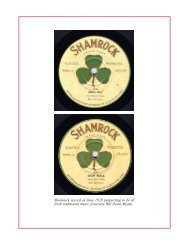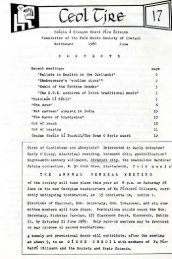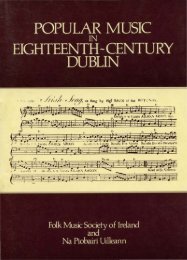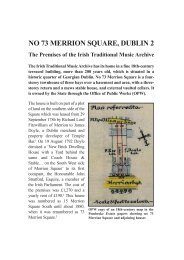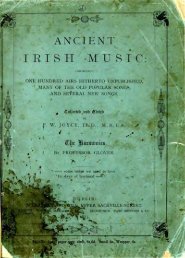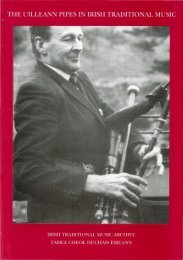Union Pipes - Irish Traditional Music Archive
Union Pipes - Irish Traditional Music Archive
Union Pipes - Irish Traditional Music Archive
You also want an ePaper? Increase the reach of your titles
YUMPU automatically turns print PDFs into web optimized ePapers that Google loves.
COURTNEY’S ‘UNION PIPES’ AND THE TERMINOLOGY OF IRISH BELLOWS-BLOWN BAGPIPES 16<br />
Henrietta Knight, Lady Luxborough (c. 1700–56), writing from<br />
Barrells Hall, Warwickshire, to the poet William Shenstone in<br />
London; the musician referred to was a trooper guarding horses on<br />
her estate:<br />
I sat last night agreeably... hearing one of the Grass-Guard<br />
Dragoons play on his German flute; which he does very well:<br />
he has also a pair of <strong>Irish</strong> Bag-pipes, with which he can play in<br />
concert; they having sixteen notes, and the Scotch but nine. He<br />
has no pipe to put to his mouth, and but very little motion with<br />
his arm; his fingers do the chief... 34<br />
In 1758 a ‘pair of fine <strong>Irish</strong> bagpipes’ was being raffled in Traquair<br />
on the Scottish borders; 35 they had belonged to a deceased piper<br />
James Smith: evidence possibly that local pipers were taking up <strong>Irish</strong><br />
instruments. Certainly an ‘<strong>Irish</strong> pipe’ inflated by bellows was known<br />
in Lowland Scotland at the period, and was recognised by a<br />
Highland bagpipes player and knowledgeable critic Joseph<br />
MacDonald, writing in 1760, as an instrument distinct from the<br />
common run of Lowland bellows pipes. He speaks of the<br />
most variegated kind of Pipe, which is the <strong>Irish</strong> Pipe. This they<br />
have neither a regular Sett of <strong>Music</strong>k or Cuttings for, but they have<br />
diversified it into Surprising Imitations of other <strong>Music</strong>k. 36<br />
34<br />
Luxborough 1775: 277. This 1751 reference is the first known occurrence of a<br />
frequently published eighteenth-century distinction made between the <strong>Irish</strong> and<br />
Scottish pipes, by which the <strong>Irish</strong> are characterised as being powered by the<br />
bellows and having a range of two octaves while the Scottish are mouth-blown<br />
and have a range of nine notes. In fact bellows-blown pipes with a range of eight<br />
or nine notes were common in Scotland in the eighteenth century: see also Note<br />
155 below.<br />
35<br />
Eytan 1999: 26.<br />
36<br />
Cannon 1994: 76. Lowland bellows-pipes chanters typically had a range of<br />
nine notes, which could be increased according to MacDonald by ‘adding<br />
Pinching Notes… By this, their Chanter has the most of the Flute Compass’. If



